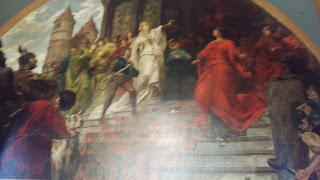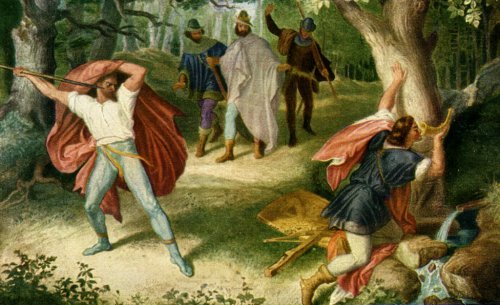What do you think?
Rate this book


408 pages, Mass Market Paperback
First published January 1, 1200
Uns ist in alten mæren · wunders vil geseitSimrock:
von helden lobebæren, · von grôzer arebeit,
von fröuden, hôchgezîten, · von weinen und von klagen,
von küener recken strîten, · muget ir nu wunder hœren sagen.
Viel Wunderdinge melden · die Mären alter ZeitJohnson/Bierwisch:
Von preiswerten Helden · von großer Kühnheit,
Von Freud’ und Festlichkeiten · von Weinen und von Klagen,
Von kühner Recken Streiten · mögt ihr nun Wunder hören sagen.
In alten Berichten wird uns Erstaunliches erzählt von berühmten Helden, von großer Not und Bedrängnis, von Festen und geselligen Freuden, von Weinen und Klagen. Ihr werdet Unerhörtes vernehmen von den Taten kühner Recken.Alice Horton (English verse translation 1898):
To us, in olden legends, · is many a marvel toldDaniel Bussier Shumway (English prose translation 1909):
Of praise-deserving heroes, · of labours manifold,
Of weeping and of wailing, · of joy and festival;
Of bold knights’ battling shall you · now hear a wondrous tale.
Full many a wonder is told us in stories old, of heroes worthy of praise, of hardships dire, of joy and feasting, of the fighting of bold warriors, of weeping and of wailing; now ye may hear wonders told.
»Di rede lât belîben«, · sprach si, »frouwe mînSimrock:
ez ist an manegen wîben · vil dicke worden schîn,
wie liebe mit leide · ze jungest lônen kan.
ich sol si mîden beide, · sône kan mir nimmer missegân«
»Die Rede laßt bleiben« · sprach sie, »Herrin mein.Johnson/Bierwisch:
Es hat an manchen Weiben · gelehrt der Augenschein,
Wie Liebe mit Leide · am Ende gerne lohnt;
Ich will sie meiden beide · so bleib’ ich sicher verschont!«
»Das mag ich nicht hören«, sagte Kriemhild. »Es ist so oft an mancher Frau offenbar geworden, daß die Freude zuletzt im Leid endet. Ich will das eine wie das andere meiden, so kann es mir nie schlecht ergehen.«Horton:
“Ah, let alone such counsel, · my mother dear I pray!Shumway:
By many a woman’s witness · ‘tis proven clear as day,
How heart’s delight too often · with sorrow sore is paid;
Lest such mischance befall me, · I’ll shun them both,” she said.
“I pray you leave this speech,” spake she, “my lady. Full oft hath it been seen in many a wife, how joy may at last end in sorrow. I shall avoid them both, then can it ne’er go ill with me.”

dô wart ir Gunther gehaz.
Dô rang er nâch ir minne unt zerfuort ir diu kleit.
dô greif nâch einem gürtel diu hêrlichiu meit.
daz was ein starker borte, den si umb ir sîten truoc.
dô tet si dem kunige grôzer leide genuoc.
Di fuoze unt ouch di hende si im zesamne bant.
si truoc in zeinem nagel unt hiene in an di want.
dô er si slâfes irrite, di minne si im verbôt.
jâ het er con ir krefte vil nâch gewunnen den tôt.
Then Gunther grew hostile towards her. He struggled for her love and tore her clothes apart. The proud maiden then reached for a girdle, a strong braid that she wore about her waist. She then caused the king sorrow in abundance. She bound together his feet and hands; she carried him over to a nail and hung him up on the wall. When he deprived her of her sleep, she forbade his love-making. Her strength had almost proved the death of him. [Cyril Edwards translation]
“‘Nune welle got von himele‘, sprach dô Gernôt,
‘ob unser tûsent waeren, wir laegen alle tôt,
der sippen dîner mâge ê wir dir einen man
gaeben hi ze gîsel. es wird et nimmer getân.‘
‘Wir müesen doch ersterben‘, sprach dô Gîselher.
‘uns scheidet niemen von ritterlicher wer.
swer gerne mit uns vehte, wir sîn et aber hie,
wande ich deheinen mînen friunt an den triuwen nie verlie.‘“


